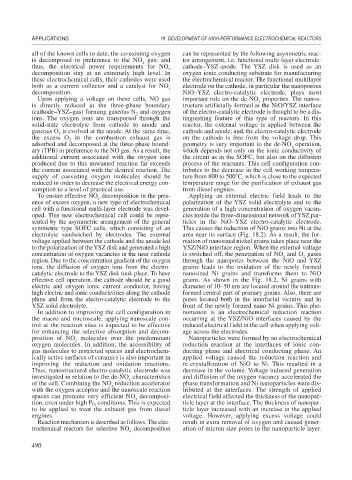Page 518 - Book Hosokawa Nanoparticle Technology Handbook
P. 518
APPLICATIONS 18 DEVELOPMENT OF HIGH-PERFORMANCE ELECTROCHEMICAL REACTORS
all of the known cells to date, the co-existing oxygen can be represented by the following asymmetric reac-
is decomposed in preference to the NO gas; and tor arrangement, i.e. functional multi-layer electrode-
x
thus, the electrical power requirements for NO x cathode–YSZ-anode. The YSZ disk is used as an
decomposition stay at an extremely high level. In oxygen ionic conducting substrate for manufacturing
these electrochemical cells, their cathodes were used the electrochemical reactor. The functional multilayer
both as a current collector and a catalyst for NO x electrode on the cathode, in particular the nanoporous
decomposition. NiO–YSZ electro-catalytic electrode, plays most
Upon applying a voltage on these cells, NO gas important role on the de-NO properties. The nanos-
x
is directly reduced at the three-phase boundary tructure artificially formed at the NiO/YSZ interface
(cathode–YSZ–gas) forming gaseous N and oxygen of the electro-catalytic electrode is thought to be a dis-
2
ions. The oxygen ions are transported through the tinguishing feature of this type of reactors. In this
solid-state electrolyte from cathode to anode and reactor, the external voltage is applied between the
gaseous O is evolved at the anode. At the same time, cathode and anode; and, the electro-catalytic electrode
2
the excess O in the combustion exhaust gas is on the cathode is free from the voltage drop. This
2
adsorbed and decomposed at the three-phase bound- geometry is very important to the de-NO operation,
x
ary (TPB) in preference to the NO gas. As a result, the which depends not only on the ionic conductivity of
additional current associated with the oxygen ions the circuit as in the SOFC, but also on the diffusion
produced due to this unwanted reaction far exceeds process of the reactants. This cell configuration con-
the current associated with the desired reaction. The tributes to the decrease in the cell working tempera-
supply of coexisting oxygen molecules should be ture from 800 to 500 C, which is close to the expected
reduced in order to decrease the electrical energy con- temperature range for the purification of exhaust gas
sumption to a level of practical use. from diesel engines.
To ensure effective NO decomposition in the pres- Applying an external electric field leads to the
x
ence of excess oxygen, a new type of electrochemical polarization of the YSZ solid electrolyte and to the
cell with a functional multi-layer electrode was devel- generation of a high concentration of oxygen vacan-
oped. This new electrochemical cell could be repre- cies inside the three-dimensional network of YSZ par-
sented by the asymmetric arrangement of the general ticles in the NiO–YSZ electro-catalytic electrode.
symmetric type SOFC cells, which consisting of an This causes the reduction of NiO grains into Ni at the
electrolyte sandwiched by electrodes. The external area near its surface (Fig. 18.2). As a result, the for-
voltage applied between the cathode and the anode led mation of nanosized nickel grains takes place near the
to the polarization of the YSZ disk and generated a high YSZ/NiO interface region. When the external voltage
concentration of oxygen vacancies in the near cathode is switched off, the penetration of NO and O gases
2
x
region. Due to the concentration gradient of the oxygen through the nanopores between the NiO and YSZ
ions, the diffusion of oxygen ions from the electro- grains leads to the oxidation of the newly formed
catalytic electrode to the YSZ disk took place. To have nanosized Ni grains and transforms them to NiO
effective cell operation, the cathode should be a good grains. As shown in the Fig. 18.2, Ni grains with
electric and oxygen ionic current conductor, having diameter of 10–50 nm are located around the untrans-
high electric and ionic conductivities along the cathode formed central part of primary grains. Also, there are
plane and from the electro-catalytic electrode to the pores located both in the interfacial vicinity and in
YSZ solid electrolyte. front of the newly formed nano Ni grains. This phe-
In addition to improving the cell configuration in nomenon is an electrochemical reduction reaction
the macro and microscale, applying nanoscale con- occurring at the YSZ/NiO interfaces caused by the
trol at the reaction sites is expected to be effective induced electrical field in the cell when applying volt-
for enhancing the selective absorption and decom- age across the electrodes.
position of NO molecules over the predominant Nanoparticles were formed by an electrochemical
x
oxygen molecules. In addition, the accessibility of reduction reaction at the interfaces of ionic con-
gas molecules to restricted spaces and electrochem- ducting phase and electrical conducting phase. An
ically active surfaces of ceramics is also important in applied voltage caused the reduction reaction and
improving the reduction and oxidation reactions. re-crystallization of NiO to Ni. This resulted in a
Thus, nanostructural electro-catalytic electrode was decrease in the volume. Voltage induced generation
investigated in relation to the de-NO characteristics and diffusion of the oxygen vacancy accelerated the
x
of the cell. Combining the NO reduction accelerator phase transformation and Ni nanoparticles were dis-
x
with the oxygen acceptor and the nanoscale reaction tributed at the interfaces. The strength of applied
spaces can promote very efficient NO decomposi- electrical field affected the thickness of the nanopar-
x
conditions. This is expected ticle layer at the interface. The thickness of nanopar-
tion, even under high P O 2
to be applied to treat the exhaust gas from diesel ticle layer increased with an increase in the applied
engines. voltage. However, applying excess voltage could
Reaction mechanism is described as follows. The elec- result in extra removal of oxygen and caused gener-
trochemical reactors for selective NO decomposition ation of micron size pores in the nanoparticle layer.
x
490

